| Valdotriton Temporal range: Early Cretaceous, | |
|---|---|
| Scientific classification | |
| Kingdom: | |
| Phylum: | |
| Class: | |
| Subclass: | |
| Order: | |
| Genus: | Valdotriton |
| Species: | †V. gracilis Evans and Milner, 1996 [1] |
Valdotriton is a genus of extinct prehistoric salamanders. Its only known species is Valdotriton gracilis (also known as the Wealden newt). V. gracilis lived during the Late Barremian in what is now Spain. [1] [2] It was found in the Las Hoyas locality. It represents one of the oldest known members of Salamandroidea. [3]
V. gracilis was a fairly small salamander, available specimens ranging from 28 millimetres (1.1 in) to 40 millimetres (1.6 in) in length, however no single specimen could decisively be determined to be an adult. In all specimens, however, the tail was longer than the torso. [2]
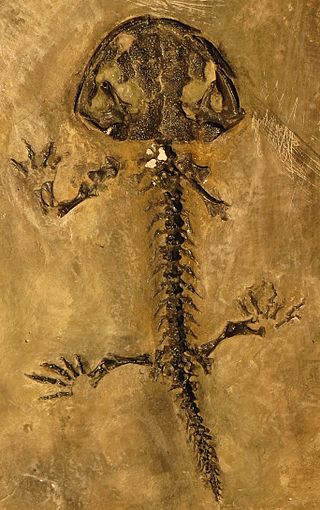
The Caudata are a group of amphibians containing the extant salamanders and all extinct species of amphibians more closely related to salamanders than to frogs. They are typically characterized by a superficially lizard-like appearance, with slender bodies, blunt snouts, short limbs projecting at right angles to the body, and the presence of a tail in both larvae and adults.
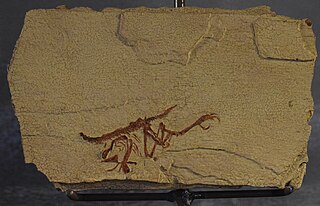
Iberomesornis is a monotypic genus of enantiornithine bird of the Cretaceous of Spain.
Spelaeogriphacea is an order of crustaceans that grow to no more than 10 millimetres (0.39 in). Little is known about the ecology of the order.

The Salamandroidea are a suborder of salamanders, referred to as advanced salamanders. The members of the suborder are found worldwide except for Antarctica, sub-Saharan Africa, and Oceania. They differ from suborder Cryptobranchoidea as the angular and prearticular bones in their lower jaws are fused, their trunk ribs are bicapitate, and all members use internal fertilization. The female is fertilized by means of a spermatophore, a sperm-containing cap placed by the male in her cloaca. The sperm is stored in spermathecae on the roof of the cloaca until it is needed at the time of oviposition.

Mantellisaurus is a genus of iguanodontian dinosaur that lived in the Barremian and early Aptian ages of the Early Cretaceous Period of Europe. Its remains are known from Belgium (Bernissart), England, Spain and Germany. The type and only species is M. atherfieldensis. Formerly known as Iguanodon atherfieldensis, the new genus Mantellisaurus was erected for the species by Gregory Paul in 2007. According to Paul, Mantellisaurus was more lightly built than Iguanodon and more closely related to Ouranosaurus, making Iguanodon in its traditional sense paraphyletic. It is known from many complete and almost complete skeletons. The genus name honours Gideon Mantell, the discoverer of Iguanodon.
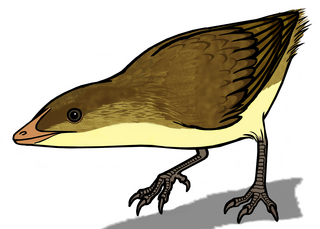
Eoalulavis is a monotypic genus of enantiornithean bird that lived during the Barremian, in the Lower Cretaceous around 125 million years ago. The only known species is Eoalulavis hoyasi.
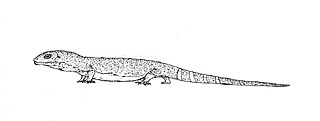
Albanerpeton is an extinct genus of salamander-like albanerpetontid amphibian found in North America, Europe and Asia first appearing in Cretaceous-aged strata. There are eight described members of the genus, and one undiagnosed species from the Paskapoo Formation, making it by far the most speciose genus in the family. Members of the genus had a robust head and neck which likely allowed them to actively burrow, characteristic of fossorial species, and they lived in a wide range of environments. This genus of amphibian was the last of its order, surviving until into the Early Pleistocene (Gelasian) of northern Italy, and possibly northern Spain, until around 2 million years ago. It likely became extinct when the region developed its present Mediterranean-type climate, having preferred one that was cold and humid. The monophyly of Albanerpeton has recently been questioned, with some authors regarding the genus as paraphyletic.

Holophagus is an extinct genus of coelacanth belonging to Latimeriidae. The type species, Holophagus gulo, is known from the Lower Jurassic marine Lias of England. Some authors have considered the genus restricted to the Lias of England.

The Albanerpetontidae are an extinct family of small amphibians, native to the Northern Hemisphere during the Mesozoic and Cenozoic. The only members of the order Allocaudata, they are thought to be allied with living amphibians belonging to Lissamphibia. Despite a superficially salamander-like bodyform, their anatomy is strongly divergent from modern amphibians in numerous aspects. The fossil record of albanerpetontids spans over 160 million years from the Middle Jurassic to the beginning of the Pleistocene, about 2.13–2 million years ago.

The La Huérguina Formation is a geological formation in Spain whose strata date back to the Barremian stage of the Early Cretaceous. Las Hoyas is a Konservat-Lagerstätte within the formation, located near the city of Cuenca, Spain. The site is mostly known for its exquisitely preserved dinosaurs, especially enantiornithines. The lithology of the formation mostly consists of lacustrine limestone deposited in a freshwater wetland environment.

Chunerpeton tianyiensis is an extinct species of salamander from the Late Jurassic Daohugou Beds in Ningcheng County, Nei Mongol, China. It is the only species classified under the genus Chunerpeton, which means "early creeping animal". It was a small animal measuring 18 cm in length. It was neotenic, with the retention of external gills into adulthood. In the original description it was placed in Cryptobranchidae, which contains modern giant salamanders. A redescription published in 2020 found it to be a stem-group caudatan outside the crown group of modern salamanders. A 2021 study found it to be a member of Cryptobranchoidea outside of Cryptobranchidae. In 2022 a more extensive analysis, with greater character and taxon sampling, recovered Chunerpeton tianyiense as a stem-group caudatan, outside the crown group of modern salamanders, and associated with Beiyanerpeton jianpingensis and Qinglongtriton gangouensis.
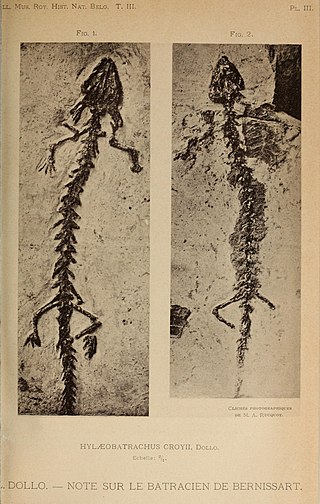
Hylaeobatrachus is an extinct genus of prehistoric salamander, known from the Early Cretaceous of Europe. The type species H. croyii is known from the Sainte-Barbe Clays Formation at the Iguanodon locality of Belgium, and was described by Louis Dollo. An unnamed Hylaeobatrachus-like taxon has also been reported from Las Hoyas, Spain. Both localities are of Barremian age. Hylaeobatrachus belongs to the crown group of modern salamanders, though its exact relationship with modern salamander groups is uncertain. It was neotenic, llike some modern salamanders.
Kokartus is an extinct genus of prehistoric stem-group salamander (Caudata) from the Middle Jurassic Balabansai Formation of Kyrgyzstan.

Marmorerpeton is an extinct genus of prehistoric stem group-salamanders that lived in Britain during the Bathonian stage of the Middle Jurassic. They are among the oldest known salamanders. Two species were named when the genus was first described by Susan E. Evans et al. in 1988, M. freemani, and M. kermacki, from fragmentary remains found via screenwashing in the Forest Marble Formation of England. Due to the size of their osteocytic lacunae suggesting a large genome size and some morphological characters, like the presence of calcified cartilage in the medulla of its humerus, it was assumed that Marmorerpeton was neotenic. New more complete remains of a new species M. wakei were described in 2022 from the Kilmaluag Formation of the Isle of Skye, Scotland. These conclusively demonstrated that Marmorerpeton was neotenic, and was a member of the family Karauridae, with the other two members of the family, Karaurus and Kokartus being known from the Middle-Late Jurassic of Central Asia. The teeth appear to have been weakly pedicellate.

Pangerpeton is an extinct genus of salamanders. Its monotypic species is Pangerpeton sinensis.
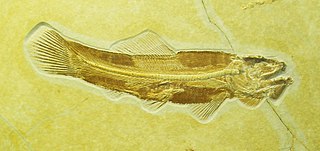
Amiopsis is an extinct genus of prehistoric bony fish belonging to the family Amiidae. Fossils are known from the Late Jurassic Solnhofen Limestone, Germany, the Early Cretaceous Purbeck Group, England, La Pedrera de Rúbies Formation, Spain and Bernnissant Iguanodon locality, Belgium and the Late Cretaceous (Cenomanian) of the Balkans. The monophyly of the genus is questionable, due to it being based on a single character, "the presence of three or more lateral fossae on each side of most abdominal centra". Remains previously assigned to this genus from the Early Cretaceous Las Hoyas, Spain have been moved into the new genus Hispanamia.
Enneabatrachus is an extinct genus of prehistoric frogs known from the late Jurassic Morrison Formation of the United States and also the Late Jurassic-Early Cretaceous Ksar Metlili Formation of Morocco. The type species is E. hechti, whose remains have been recovered from stratigraphic zone 5.

Sinaeschnidia is a genus of prehistoric dragonfly. S. heishankowensis is a common component of the Jehol Biota of northeastern China. It is known from numerous specimens, both nymphs and imagos (adults). S. martinezdelclosi is known from slightly earlier deposits in Las Hoyas, Spain.
Meyasaurus is an extinct genus of Teiid lizard known from the Barremian of Spain and the Isle of Wight, UK. Four species are known from Spain, from the La Huérguina, Camarillas, and La Pedrera de Rúbies Formations while an indeterminate taxon is known from the Wessex Formation of Isle of Wight. It is a possible close relative of Barbatteius and other members of Barbatteiidae.

Yaksha perettii is an extinct species of albanerpetontid amphibian, and the only species in the genus Yaksha. It is known from three specimens found in Cenomanian aged Burmese amber from Myanmar. The remains of Yaksha perettii are the best preserved of all albanerpetontids, which usually consist of isolated fragments or crushed flat, and have provided significant insights in the morphology and lifestyle of the group.